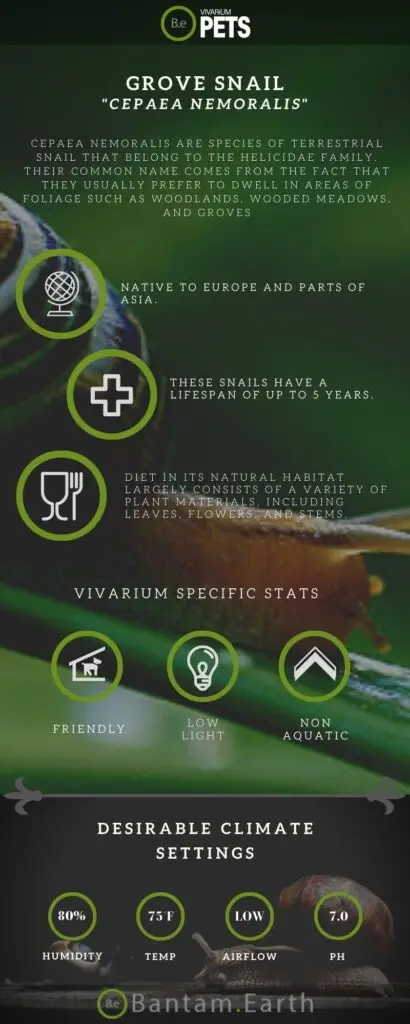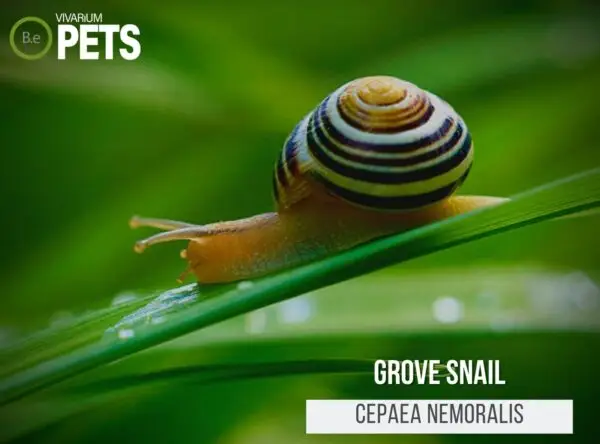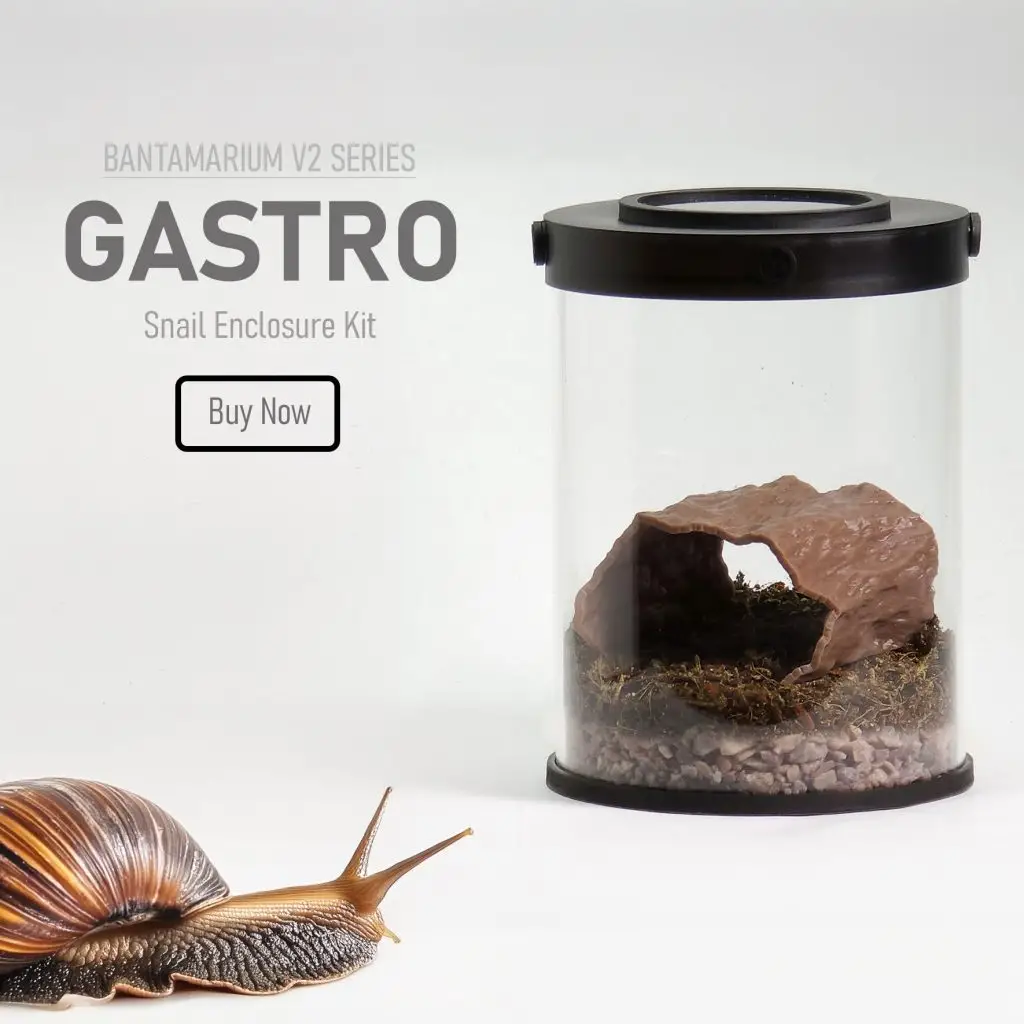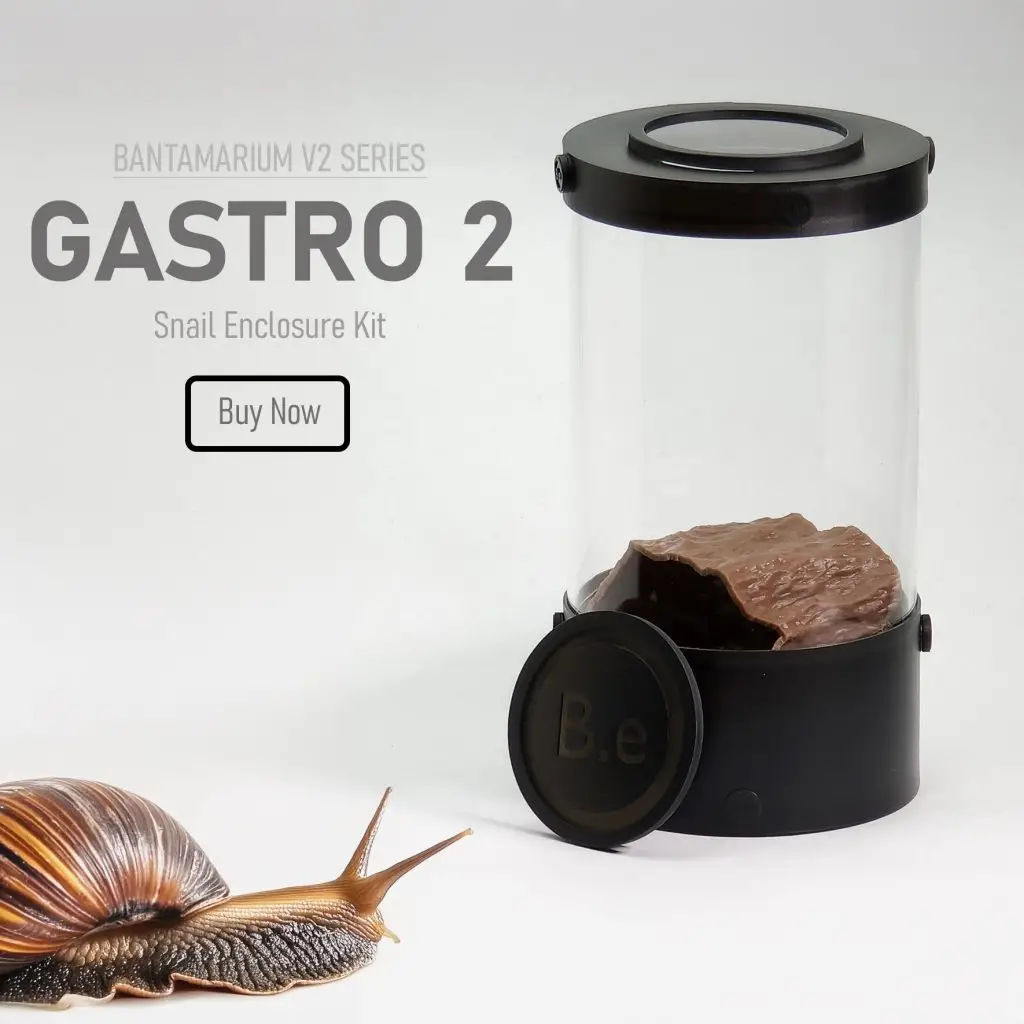Grove snails (Cepaea nemoralis) are an interesting and often overlooked species of terrarium snail.
These small creatures are full of personality, making them excellent and low-maintenance pets to care for.
In this guide, we’ll cover all you need to know to give your grove snail a healthy home, including supplies, tank setup, feeding, maintenance, and more.
Whether you’re just starting with pet snails or have experience caring for them, this article will provide all the info you need to be a successful grove snail caretaker.
Table Of Contents:
ToggleWhat Are Grove Snails?
Cepaea nemoralis is a species of terrestrial snail that belongs to the Helicidae family.
These small snails are native to Europe, Asia, and North America.
Their common name comes from the fact that they usually prefer to dwell in areas of foliage such as woodlands, wooded meadows, and groves.
With their attractive shells and easy-going temperament, grove snails make for wonderful pet companions.
Create an ideal habitat for your pet snails with our Customizable Snail Enclosure Kits, which include everything you need to get started.
What Do Grove Snails Look Like?
Cepaea nemoralis are considered one of the most common types of snails in Europe.
They are medium-sized mollusks, typically growing to be about 2.2 centimeters long.
Groves snails can be identified by their smooth, glossy, yellowish, or reddish-brown shells which contain 4-6 spiral whorls.
Other identifying features of grove snails include a columella (the core of the snail’s shell), which is usually white or yellowish, and a lip along the mouth of the shell, which can be slightly thickened.
Additionally, Cepaea nemoralis often have darker brown stripes on their shells and mantles. The interior of the shell is usually ash-gray or whitish.
These snails have eyes located on the tips of the first and second pairs of tentacles, while their mouth has a file-like tongue, known as a radula.
The snails have a muscular foot which allows them to crawl.
Benefits Of Using Grove Snails
Grove snails make excellent additions to vivariums of all sizes.
These small creatures are not only interesting and full of personality, but offer a handful of practical benefits, too.
One of the main advantages of using these snails for vivariums is their ability to help maintain the environment.
They feast on leftover food and decaying plant material, thus helping to keep the tank clean and clear of debris.
They also help aerate the soil, consuming tiny particles that would otherwise decay and cause foul odors.
Snails are not known to eat healthy vivarium plants or animals, so they’re a safe option that can be enjoyed by your other tank inhabitants.
Finally, grove snails are a nice aesthetic piece, adding diversity and interest to your tank.

Grove Snail Facts
Cepaea nemoralis are small creatures with a diverse diet – they mostly feed on detritus, decaying vegetation, and small decaying invertebrates.
They can live for many years in captivity, depending on the temperature and humidity levels of their environment.
They are generally non-aggressive, social snails that can coexist in small groups but tend to breed slowly.
Habitat
Cepaea nemoralis is a species of air-breathing land snail native to Europe and parts of Asia.
They are widely distributed across the continent and can be found in all kinds of habitats, though they usually favor damp and shady environments such as woodland areas.
They can even be found in urban locations, such as parks and gardens.
In the wild, these snails often move around in groups and can reach very high densities in suitable habitats.
Our Bioactive Land Snail Substrate Blend is specially formulated to meet the needs of various land snail species, providing an optimal balance of moisture and nutrients.
Diet
The diet of a grove snail in its natural habitat largely consists of a variety of plant materials, including leaves, flowers, and stems.
In addition, they may also consume algae and microscopic organisms like bacteria and fungi.
They breed in spring and autumn when temperatures and humidity levels are optimal, and their diet may reflect this.
During warmer months, they may be more inclined to munch on live plants, while in cooler months they are more likely to graze on decaying vegetation and leaf matter.
In terms of food size and texture, grove snails do best with smaller pieces, as they are not strong enough to break down larger items.
Temperament
Cepaea nemoralis are generally quite peaceful and non-aggressive towards humans and other animals.
They have very poor sight, so they tend to rely more on their sense of smell and touch than their vision.
When handled, they typically remain still and quiet, periodically retracting into their shells to investigate their surroundings.
They can be quite trusting creatures in the right environment, often slowly moving closer to investigate your hand for a potential meal.
In general, it’s best to avoid housing them with predators as they can easily become prey.
Lifespan
Cepaea nemoralis are known to have a lifespan of one to two years in the wild, although in captivity some have been known to live up to five years.
During this time, they have three distinct stages: egg, juvenile, and adult.
The eggs are laid in the substrate and hatch in about four weeks, producing juveniles that reach adulthood in another month or so.
Adulthood is considered to be the longest stage and marks when the snails are sexually mature and able to reproduce.
Grove snails reach sexual maturity in one to two months and begin reproducing quickly afterward.
An adult snail can lay hundreds of eggs, depending on the age and size of the snail.
The eggs are paper-like and may be difficult to spot right away on dark-colored substrates.
The eggs take up to four weeks to hatch, after which the juvenile snail will emerge.
Breeding
Grove snails are hermaphrodites, meaning each snail produces eggs and carries sperm.
During mating season (usually during the spring and summer), the two snails engage in courtship for a few hours up to a few days.
This courtship often consists of rub-based activities, such as the two snails rubbing their heads together and tapping each other with their tentacles.
Once mating is complete, the snails will each produce a clutch of about 10-50 eggs.
These eggs can be deposited on the tank walls or terrarium substrate and will hatch after a few weeks.
Upon hatching, the snails will be ready to live and feed on their own with no parental care.
Where To Find Grove Snails
Finding grove snails for sale or in the wild is relatively easy if you know what to look for.
In the wild, grove snails can be found primarily in Europe and parts of northern Africa, as well as some areas of Asia.
They typically inhabit wooded areas and live among leaf litter, making them well-camouflaged.
As such, they may be harder to find in your backyard or a park, but patience and a keen eye will usually result in a successful hunt.
In terms of buying Grove snails, you may not find them in most pet stores or reptile shops, but many online distributors and breeders specialize in these snails.
You can also look for snail breeders at reptile expos or reptile-focused shows.
Regardless of where you purchase your grove snail, make sure to check for diseases and illnesses before taking them home.
Grove Snail Care
Grove Snails need a clean and comfortable tank, including a substrate and decorations, as well as proper feeding and maintenance.
Temperature and humidity should also be monitored.
With regular handling and care, these intelligent and endearing snails can bring a lot of joy to their caretaker.
Tank Requirements
The ideal tank for Grove Snails should be a terrarium or paludarium with a capacity of 10 gallons.
A pH of 6.0-8.0 is ideal and a hardness level of 8-10 dH is preferred.
The temperature should stay between 50 and 86 degrees Fahrenheit.
The substrate should consist of coconut fiber, peat moss, and vermiculite.
It is important to provide plenty of hiding spots, as well as plants and other decorations for the snail to explore.
Terrarium lighting should be dim or indirect light, as direct sunlight can be too bright for the snail.
What Do Grove Snails Eat?
A balanced diet is important for any pet, and grove snails are no exception! Here’s a simple guide on how to feed Cepaea nemoralis:
- Provide a variety of food sources. Grove snails thrive on protein-rich foods such as shrimp, cricket, and worms. You can also offer them vegetables such as lettuce, carrots, and celery. Fruit is also acceptable in moderation, although it is not necessary for their diet.
- Offer food twice a day. Feed your grove snail once in the morning and again at night. When feeding, make sure to only offer a small amount of food that can be consumed in a few hours. Excess food can lead to health issues.
- Supplement with calcium. Calcium is essential for snails to maintain healthy shells. You can supplement their diet with cuttlebone or crushed eggshells.
- Remove uneaten food. Leftover food can dirty and cloud the tank, as well as lead to health issues. Make sure to remove any uneaten food every day.
If you’re more of an avid hobbyist like myself, be sure to check out my ultimate DIY land snail food guide. I give a more in-depth explanation of the best foods and my favorite recipe.
Best Tankmates For Grove Snails
Since grove snails are typically kept in smaller vivariums, it’s important to consider the right tank mates.
The most suitable tankmates for grove snails are peaceful and slow-moving aquatic creatures that won’t disturb or eat them, such as guppies, tetras, and even other snail species.
It’s important to ensure the tank has enough space for their tankmates to move while still giving grove snails room to move around.
It’s also essential to note that grove snails are sensitive to bright light and stir in the water, so it’s best to avoid tank mates that can produce too much of this.
Therefore, predatory or fast-moving species, like cichlids, should be avoided.
Additionally, to prevent overstocking, it’s important to consider the growth rate of each species.
Although slow-growing and small grove snails need little space, don’t forget to leave room for their tankmates to grow, as well.
Conclusion
Cepaea nemoralis are a fascinating and unique species that can provide hours of entertainment and joy to anyone who cares for them.
By following the tips in this guide, your snail should have a comfortable living space and stay healthy and happy for many years.
With the right supplies and care, you can enjoy watching your grove snail explore and flourish in its habitat.
Thank you for taking the time to learn more about this incredible species and we wish you the best of luck in caring for your pet snail!
Create the ideal habitat for your snails with our species-specific soil mixes and Insect Enclosure Kits. These products provide everything you need for a successful and thriving snail habitat.
Frequently Asked Questions
Grove snails are known to lay relatively small clutches of eggs, usually ranging from 30 to 80 eggs per clutch.
The number of eggs laid may depend on various factors, such as the age and health of the snail, as well as environmental conditions such as temperature and humidity.
Grove snails are generally quite small, with adult snails typically ranging in size from 20-22mm in shell diameter, although some may grow up to 35mm in exceptional cases.
The size of the snail may depend on various factors, including genetics, diet, and environmental conditions such as temperature and humidity.
Grove snails are not considered to be invasive in all parts of the world, as they are native to much of Europe and have been introduced to other regions as well.
However, in some areas outside of their native range, such as in parts of North America, grove snails have been classified as an invasive species. This is because they can outcompete native snail species for resources and may cause other ecological disturbances.
Grove snails grow rapidly, reaching maturity in as little as one year.
Grove snails typically live for 2-3 years in the wild but can survive up to 6 years under favorable conditions.
The age at which they reach sexual maturity and their growth rate can also vary depending on factors such as genetics, diet, and environmental conditions.
Grove snails mainly feed on vegetation such as leaves, flowers, and stems. In captivity, they can be fed a variety of fresh vegetables, fruits, and plants, including lettuce, spinach, carrot, apple, and cucumber.
Grove snails (Cepaea nemoralis) are not considered to be endangered, as they are a widespread and common species throughout much of their native range in Europe and have also been introduced to other regions.
The grove snail, Cepaea nemoralis, displays a wide range of colors and patterns on its shell due to a combination of genetic and environmental factors. The variation in shell color and pattern may serve functions such as camouflage, thermoregulation, and/or mate recognition, but the reason for its evolution is not fully understood.







